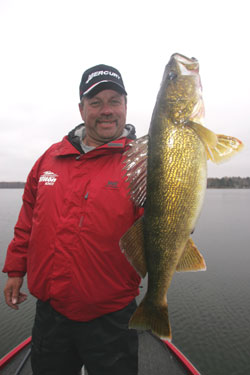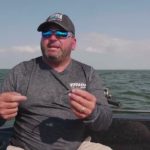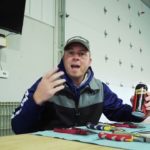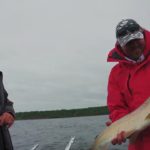Bonus Time
 In today’s video game world, the more success one enjoys, the longer one gets to play and the more rewards one gets to collect.
In today’s video game world, the more success one enjoys, the longer one gets to play and the more rewards one gets to collect.
I’m not into the cartoon characters, ogres, warriors and heroes who are the focal points of many of these fantasy adventures.
In fact, if anyone asked me to design a video game, it would be a fishing challenge. I would probably use November as the model because it’s a month that keeps on giving and offers endless opportunities. It’s bonus time.
My game would require players to first go shopping at the Tackle Shop, then choose a body of water (either rivers or lakes). Then they’d have an opportunity to earn more equipment and conquer increasingly difficult challenges featuring multiple species using only what they’d been able to procure before wetting a line.
That’s November angling. It’s a time of year when walleyes, crappies, smallmouth bass, largemouth bass, white bass, northern pike, muskies, catfish and perch can all be caught – often from the same general areas using just two or three lures.
Let’s go shopping. You get $150 to spend for starters. You’ll have to use it wisely to cover all your bases.
The first thing you’ll need is a versatile rod-and-reel combo that can handle fish ranging from a pound to 20 pounds or more. A 6-foot, medium-action Quantum Alliance spinning rod equipped with an Incyte spinning reel will cost you around $100 and is about as versatile as it gets.
It will cost you another $10 for line, and since you will be fishing from shore at the outset while trying to work your way up, you might want to consider an inexpensive net. That doesn’t leave much money for lures, but you shouldn’t need much more than a handful of jigs, some plastic grub tails, a couple of crankbaits and a little terminal tackle to get started. You can add to your tackle box later if your angling skills are good enough.
Now you are ready to hit the water. You’ve chosen the lake mode. To earn your boat and another trip to the Tackle Shop, you must catch a limit of walleyes and a minimum of three species of fish.
 Fortunately, when lakes turn over, or destratify, in the fall, oxygen mixes throughout the water column. That means fish that avoided the shallows or depths during the summer months are now using the entire water column again, and that makes them available to even shore anglers.
Fortunately, when lakes turn over, or destratify, in the fall, oxygen mixes throughout the water column. That means fish that avoided the shallows or depths during the summer months are now using the entire water column again, and that makes them available to even shore anglers.
A quick study of the lake and evaluation of the conditions should help you narrow down the best spots. In general, you’ll want to focus your efforts on the wind-blown side of the lake. Then single out the edges of decaying weedbeds, rock shorelines, sloping points or any structure you can reach from shore, such as humps or rockpiles. Look for areas with deep water nearby.
November walleyes are shallow for one reason – to eat. They are aggressive when you find them, so it’s not hard to catch them. Try casting 1/4-ounce jigs tipped with Uncle Josh grub tails and No. 5 or No. 7 Normark Shad Raps or Fat Raps. If it’s a clear-water lake, concentrate your efforts during low-light periods. If the water is stained, the bite will carry into the day. And if you don’t contact fish in a few minutes, keep moving until you find them.
If you chose well at the Tackle Shop, you’ve selected color patterns and crankbait styles that will catch a variety of species, so you’ll probably be able to reach some of the game’s other goals while working on the walleyes.
November crappies, for example, seem to relate to rock with some depth around it, and they’re aggressive enough to hit a No. 5 Shad Rap or a quarter-ounce jig. Largemouth and smallmouth bass are putting on the feedbag, as well, and can be found along the deeper edges of dropoffs or on the deep rock waiting to ambush prey. Sometimes, they will suspend in these areas.
Jig-and-plastic combos are probably the best way to reach these fish, although lipless Rattlin’ Raps are a good choice, too, because you can allow them to sink like a jig to the proper depth. They will also entice a hungry walleye.
Chances are, you’ll catch some other species along the way. Fall catfish hang around deep-water points and rocks, perch show up in these areas, and drum are frequent visitors to the shallows and sharp breaklines. You’ll encounter the occasional northern pike, as well, and you never know where white bass will show up, but it’s usually near some type of structure where they can herd baitfish and gorge on them. Jigs will catch them all.
 If you’re good, you’ve earned enough credit to at least supplement your tackle box before the next level. If you’re really good, you now own a boat and will be able to expand your range considerably where you can put some deeper-diving crankbaits into play such as the wider-bodied, Rapala DT10s that plunge quickly with a few turns of the reel. And if you keep succeeding, you’ll be able to accessorize with an Optima battery-powered MinnKota Terrova bow-mount trolling motor, a Lowrance 113HD sonar/GPS unit and perhaps a Mercury kicker motor that you’ll need when you get to the toughest levels.
If you’re good, you’ve earned enough credit to at least supplement your tackle box before the next level. If you’re really good, you now own a boat and will be able to expand your range considerably where you can put some deeper-diving crankbaits into play such as the wider-bodied, Rapala DT10s that plunge quickly with a few turns of the reel. And if you keep succeeding, you’ll be able to accessorize with an Optima battery-powered MinnKota Terrova bow-mount trolling motor, a Lowrance 113HD sonar/GPS unit and perhaps a Mercury kicker motor that you’ll need when you get to the toughest levels.
If you’ve selected rivers to fish, the same basic equipment and lures will get you started, although live bait such as minnows and chubs could be important additions to your arsenal.
At Level 1, you’ll probably want to focus on the tailwaters below a lock and dam and find a shoreline that offers depth and rock. November walleyes and sauger congregate below these dams, and jigs are a great way to catch them.
Most river systems also have wingdams, closing dams, eddies and large flats in the same areas that will produce drum, catfish, largemouth bass and smallmouth bass. Look, too, for inside and outside bends in the river channel where walleyes, as well as other species, stack up during their fall migration.
Feeder creeks that hook up with the main channel and dive to depths of 20 feet or more hold late-fall smallmouths. As for crappies, largemouth bass northern pike, they tend to favor less current. Rock shorelines where a hard-bottomed shelf plunges quickly to depths of 20 feet or so are great places to find crappies and largemouth while northern pike action can be fantastic in the slower sloughs off the main channel.
As you progress through the game as a river angler, you’ll want to add lead-core line and trolling rods to your arsenal that will help you effectively fish some of the river bends and breaklines that hold fish. You’ll need a trolling motor with a strong battery system and quality sonar. And if your main outboard engine is larger than about 50 horsepower, a kicker motor is a must.
No matter how far you take it, November fishing is bonus time. The same lures will catch multiple species in the same areas. Get your game face on and get after it.





